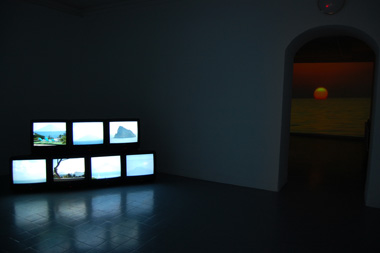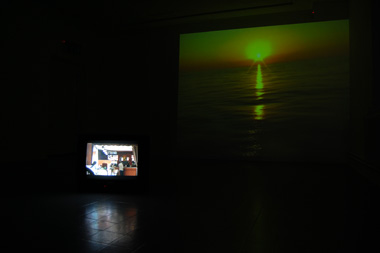 |
| Finola Jones: It’s why [blue] birds sing – cat, 2006, installation shot, Butler Gallery (DVD stills); courtesy the artist |
Butler Director Anna O’Sullivan’s innovative idea to organise bus trips from Dublin to the Butler Gallery, Kilkenny was inaugurated on Sunday 14 January with a visit to Finola Jones’ enigmatically titled show It’s why [blue] birds sing . Jones’ sculptural, audiovisual show was designed for the Butler Gallery and draws on her self-professed love of travelling and collecting. From close observation, meticulous selection and presentation, the artist conjured up a world where nothing is quite what it seems, with oblique references to Alice’s adventures in Wonderland in the manner in which one experienced the journey through the gallery.
The four rooms of the Butler Gallery open onto each other and one must retrace one’s steps from the innermost room. The sound of birds signalled arrival. Jones’ use of the space was spare and effective. Moving through from one space to the next, the viewer caught a glimpse of a spectacular sunset in the distance. A lean sleeping cat marked the entry (a gatekeeper?). Stretched out, it occupied two monitors placed side by side on the floor. The bulk of its body filled the larger screen and its hindquarters, the smaller. A gentle breeze ruffling the cat’s fur was the only movement except for an occasional irritated flick of the tail. Sleeping domestic animals may well be part of Jones’ signature, as the artist previously featured a sleeping dog in a railway station in her work, Artificially constructed habitats (Temple Bar Gallery, 2005; see review here ).
 |
| Finola Jones: It’s why [blue] birds sing – volcano, 2006, installation shot, Butler Gallery (DVD stills); courtesy the artist |
The second space brought one to the counterposing sweet and raucous sounds of the birds, which surprisingly emanated from a grand piano covered in a somewhat nostalgic, elegant fabric. On closer inspection, the piano was a mock-up and the fabric (made by the artist), while beautifully patterned with nesting blue birds, was made of stretchy material reminiscent of cheap couch covers. The sweet melodic sound was that of an Australian butcher bird, a songbird known for the unusual habit of hanging its prey for display before eating and the raucous cawing of a raven, a harbinger of death. Did the [blue] bird of the title [in parentheses] also sing or was it just part of the fabric? Drifting piano music added to the cacophony.
 |
| Finola Jones: It’s why [blue] birds sing – volcano, 2006, installation shot, Butler Gallery (DVD stills); courtesy the artist |
Stacked monitors (seven in all) formed a low wall in the next space and showed multiple shots of Stromboli, one of Italy’s Aeolian Islands and an idyllic holiday destination. A semi-active volcano, it is famous for its spectacular gas explosions. Here looking from one screen to the other to try and register any change, the viewer became engaged in a type of environmental surveillance. Landscape like this is always full of disquieting contradictions. I was reminded of the fate of the natural historian Pliny who observed the eruption of Vesuvius and died trying to rescue people from the heavily populated coastline.
 |
| Finola Jones: It’s why [blue] birds sing – Moscow, 2006, installation shot, Butler Gallery (DVD stills); courtesy the artist |
The final room housed a spectacular red sunset, perhaps filmed in the vicinity of Stromboli as deep-red sunsets can result as a consequence of volcanic activity. A monitor, placed on the floor in front of the sunset, showed a jaded Eastern European hotel where a pianist rather franticly played the piano above the noise of the uninterested, chatting guests and bored clatter of the waiters and waitresses. The birds could still be heard from the fake piano, while the pianist played melancholic tunes such as Somewhere over the rainbow and Strangers in the night . Turning reluctantly away from the sunset, the viewer retraced her steps past the sleeping cat.
Jones successfully brings together sound, image, object and space in the minimalist sculptural arrangement of the installation. This arrangement dictates the pace, allowing the viewer to ponder and engage with the work, letting the inherent metaphors shape our experience. Emotional cues were colour-coded as the screens faded to pink in the first room, blue in the third and red in the last room or perhaps the colours marked sites of emotion? Readers of Alice’s adventures invariably fall into one of two groups: either they seek to decode a meaning or, like Alice, enjoy the story and find their own meaning. Falling into the first camp and taking into consideration Jones’ keen observation of the natural world, the exhibition could be interpreted as confronting bleak realities, a metaphor for impending global disasters that we are party to, as we immerse ourselves in the manufactured, holiday idyll.
Ruth Devine is a researcher / art historian.